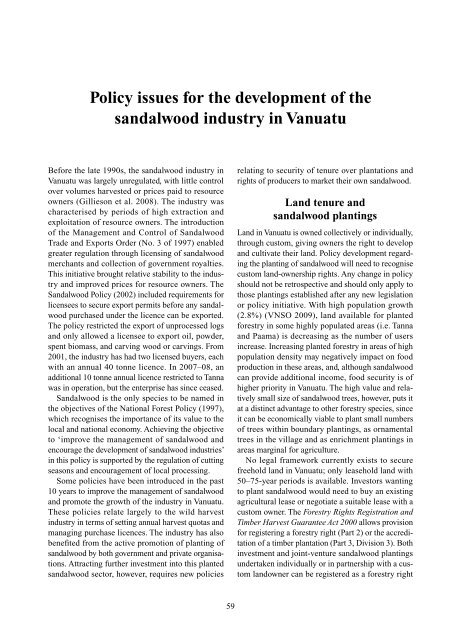Opportunities for the smallholder sandalwood industry in ... - ACIAR
Opportunities for the smallholder sandalwood industry in ... - ACIAR
Opportunities for the smallholder sandalwood industry in ... - ACIAR
You also want an ePaper? Increase the reach of your titles
YUMPU automatically turns print PDFs into web optimized ePapers that Google loves.
Policy issues <strong>for</strong> <strong>the</strong> development of <strong>the</strong><br />
<strong>sandalwood</strong> <strong><strong>in</strong>dustry</strong> <strong>in</strong> Vanuatu<br />
Be<strong>for</strong>e <strong>the</strong> late 1990s, <strong>the</strong> <strong>sandalwood</strong> <strong><strong>in</strong>dustry</strong> <strong>in</strong><br />
Vanuatu was largely unregulated, with little control<br />
over volumes harvested or prices paid to resource<br />
owners (Gillieson et al. 2008). The <strong><strong>in</strong>dustry</strong> was<br />
characterised by periods of high extraction and<br />
exploitation of resource owners. The <strong>in</strong>troduction<br />
of <strong>the</strong> Management and Control of Sandalwood<br />
Trade and Exports Order (No. 3 of 1997) enabled<br />
greater regulation through licens<strong>in</strong>g of <strong>sandalwood</strong><br />
merchants and collection of government royalties.<br />
This <strong>in</strong>itiative brought relative stability to <strong>the</strong> <strong><strong>in</strong>dustry</strong><br />
and improved prices <strong>for</strong> resource owners. The<br />
Sandalwood Policy (2002) <strong>in</strong>cluded requirements <strong>for</strong><br />
licensees to secure export permits be<strong>for</strong>e any <strong>sandalwood</strong><br />
purchased under <strong>the</strong> licence can be exported.<br />
The policy restricted <strong>the</strong> export of unprocessed logs<br />
and only allowed a licensee to export oil, powder,<br />
spent biomass, and carv<strong>in</strong>g wood or carv<strong>in</strong>gs. From<br />
2001, <strong>the</strong> <strong><strong>in</strong>dustry</strong> has had two licensed buyers, each<br />
with an annual 40 tonne licence. In 2007–08, an<br />
additional 10 tonne annual licence restricted to Tanna<br />
was <strong>in</strong> operation, but <strong>the</strong> enterprise has s<strong>in</strong>ce ceased.<br />
Sandalwood is <strong>the</strong> only species to be named <strong>in</strong><br />
<strong>the</strong> objectives of <strong>the</strong> National Forest Policy (1997),<br />
which recognises <strong>the</strong> importance of its value to <strong>the</strong><br />
local and national economy. Achiev<strong>in</strong>g <strong>the</strong> objective<br />
to ‘improve <strong>the</strong> management of <strong>sandalwood</strong> and<br />
encourage <strong>the</strong> development of <strong>sandalwood</strong> <strong>in</strong>dustries’<br />
<strong>in</strong> this policy is supported by <strong>the</strong> regulation of cutt<strong>in</strong>g<br />
seasons and encouragement of local process<strong>in</strong>g.<br />
Some policies have been <strong>in</strong>troduced <strong>in</strong> <strong>the</strong> past<br />
10 years to improve <strong>the</strong> management of <strong>sandalwood</strong><br />
and promote <strong>the</strong> growth of <strong>the</strong> <strong><strong>in</strong>dustry</strong> <strong>in</strong> Vanuatu.<br />
These policies relate largely to <strong>the</strong> wild harvest<br />
<strong><strong>in</strong>dustry</strong> <strong>in</strong> terms of sett<strong>in</strong>g annual harvest quotas and<br />
manag<strong>in</strong>g purchase licences. The <strong><strong>in</strong>dustry</strong> has also<br />
benefited from <strong>the</strong> active promotion of plant<strong>in</strong>g of<br />
<strong>sandalwood</strong> by both government and private organisations.<br />
Attract<strong>in</strong>g fur<strong>the</strong>r <strong>in</strong>vestment <strong>in</strong>to this planted<br />
<strong>sandalwood</strong> sector, however, requires new policies<br />
relat<strong>in</strong>g to security of tenure over plantations and<br />
rights of producers to market <strong>the</strong>ir own <strong>sandalwood</strong>.<br />
Land tenure and<br />
<strong>sandalwood</strong> plant<strong>in</strong>gs<br />
Land <strong>in</strong> Vanuatu is owned collectively or <strong>in</strong>dividually,<br />
through custom, giv<strong>in</strong>g owners <strong>the</strong> right to develop<br />
and cultivate <strong>the</strong>ir land. Policy development regard<strong>in</strong>g<br />
<strong>the</strong> plant<strong>in</strong>g of <strong>sandalwood</strong> will need to recognise<br />
custom land-ownership rights. Any change <strong>in</strong> policy<br />
should not be retrospective and should only apply to<br />
those plant<strong>in</strong>gs established after any new legislation<br />
or policy <strong>in</strong>itiative. With high population growth<br />
(2.8%) (VNSO 2009), land available <strong>for</strong> planted<br />
<strong>for</strong>estry <strong>in</strong> some highly populated areas (i.e. Tanna<br />
and Paama) is decreas<strong>in</strong>g as <strong>the</strong> number of users<br />
<strong>in</strong>crease. Increas<strong>in</strong>g planted <strong>for</strong>estry <strong>in</strong> areas of high<br />
population density may negatively impact on food<br />
production <strong>in</strong> <strong>the</strong>se areas, and, although <strong>sandalwood</strong><br />
can provide additional <strong>in</strong>come, food security is of<br />
higher priority <strong>in</strong> Vanuatu. The high value and relatively<br />
small size of <strong>sandalwood</strong> trees, however, puts it<br />
at a dist<strong>in</strong>ct advantage to o<strong>the</strong>r <strong>for</strong>estry species, s<strong>in</strong>ce<br />
it can be economically viable to plant small numbers<br />
of trees with<strong>in</strong> boundary plant<strong>in</strong>gs, as ornamental<br />
trees <strong>in</strong> <strong>the</strong> village and as enrichment plant<strong>in</strong>gs <strong>in</strong><br />
areas marg<strong>in</strong>al <strong>for</strong> agriculture.<br />
No legal framework currently exists to secure<br />
freehold land <strong>in</strong> Vanuatu; only leasehold land with<br />
50–75-year periods is available. Investors want<strong>in</strong>g<br />
to plant <strong>sandalwood</strong> would need to buy an exist<strong>in</strong>g<br />
agricultural lease or negotiate a suitable lease with a<br />
custom owner. The Forestry Rights Registration and<br />
Timber Harvest Guarantee Act 2000 allows provision<br />
<strong>for</strong> register<strong>in</strong>g a <strong>for</strong>estry right (Part 2) or <strong>the</strong> accreditation<br />
of a timber plantation (Part 3, Division 3). Both<br />
<strong>in</strong>vestment and jo<strong>in</strong>t-venture <strong>sandalwood</strong> plant<strong>in</strong>gs<br />
undertaken <strong>in</strong>dividually or <strong>in</strong> partnership with a custom<br />
landowner can be registered as a <strong>for</strong>estry right<br />
59
















